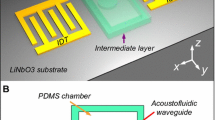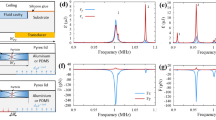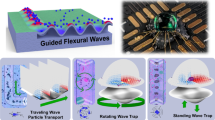Abstract
Acoustic wave-based manipulation of cells and particles in microfluidic channels has gained wide popularity in the past decade since it provides label-free and contact-less manipulation of them in a microfluidic environment using a very simple microfluidic structure and experimental setup. In bulk acoustofluidics, an acoustic resonance field that generates an acoustic standing wave within a microfluidic channel creates acoustic pressure nodes and anti-nodes, to which particles migrate to or migrate away from. However, in a given straight microfluidic channel, the position of the acoustic pressure nodes and anti-nodes are fixed and cannot be changed along the channel, limiting more diverse capabilities in moving particles and cells to a desired location within a microfluidic channel. Here, an acoustic echo-channel where its width changes along the flow direction was created right next to the main flow channel separated by a thin wall that minimizes the disturbance of the acoustic wave. This allows the location of the acoustic pressure nodes and anti-nodes to be controlled in the main flow channel depending on the width of the echo-channel, hence providing more flexibility in manipulating particles and cells to a certain position within a given microfluidic channel. The capability to more freely manipulate particles and cells within a microfluidic channel further expands the application areas of bulk acoustofluidics.




Similar content being viewed by others
References
Antfolk M, Laurell T (2019) Acoustofluidic Blood Component Sample Preparation and Processing in Medical Applications. In applications of microfluidic systems in biology and medicine Springer, Singapore, pp 1–25
Antfolk M, Magnusson C, Augustsson P, Lilja H, Laurell T (2015) Acoustofluidic, label-free separation and simultaneous concentration of rare tumor cells from white blood cells. Anal Chem 87(18):9322–9328
Arnold FJ, Gonçalves MS, Bravo-Roger LL, Mühlen SS (2015) Electric impedance of piezoelectric ceramics under acoustic loads. ECTI Trans Electr Eng Electron Commun 12(2):48–54
Cushing KW, Garofalo F, Magnusson C, Ekblad L, Bruus H, Laurell T (2017) Ultrasound characterization of microbead and cell suspensions by speed of sound measurements of neutrally buoyant samples. Anal Chem 89(17):8917–8923
Destgeer G, Cho H, Ha BH, Jung JH, Park J, Sung HJ (2016) Acoustofluidic particle manipulation inside a sessile droplet: four distinct regimes of particle concentration. Lab Chip 16(4):660–667
Ding, Xiaoyun, Sz-Chin Steven Lin, Brian Kiraly, Hongjun Yue, Sixing Li, I-Kao Chiang, Jinjie Shi, Stephen J. Benkovic, Tony Jun Huang (2012) "On-chip manipulation of single microparticles, cells, and organisms using surface acoustic waves." Proceedings of the National Academy of Sciences109, no. 28: 11105–11109.
Evander M, Nilsson J (2012) Acoustofluidics 20: Applications in acoustic trapping. Lab Chip 12(22):4667–4676
Fong EJ, Johnston AC, Notton T, Jung SY, Rose KA, Weinberger LS, Shusteff M (2014) Acoustic focusing with engineered node locations for high-performance microfluidic particle separation. Analyst 139(5):1192–1200
Fornell A, Nilsson J, Jonsson L, Periyannan Rajeswari PK, Joensson HN, Tenje M (2015) Controlled lateral positioning of microparticles inside droplets using acoustophoresis. Anal Chem 87(20):10521–10526
Haynes (2014) William M. CRC handbook of chemistry and physics. CRC press
Hopcroft MA, Nix WD, Kenny TW (2010) What is the Young's Modulus of Silicon? J Microelectromech Syst 19(2):229–238
Jung SY, Notton T, Fong E, Shusteff M, Weinberger LS (2015) Spatial tuning of acoustofluidic pressure nodes by altering net sonic velocity enables high-throughput, efficient cell sorting. Lab Chip 15(4):1000–1003
Leibacher I, Schatzer S, Dual J (2014) Impedance matched channel walls in acoustofluidic systems”. Lab Chip 14(3):433–610
Lenshof A, Magnusson C, Laurell T (2012) Acoustofluidics 8: Applications of acoustophoresis in continuous flow microsystems. Lab Chip 12(7):1210–1223
Park JW, Kim SH, Ito T, Fujii T, Kim SY, Laurell T, Lee SW, Goda K (2016) Acoustofluidic harvesting of microalgae on a single chip. Biomicrofluidics 10(3):034119
Pothuri C, Azharudeen M, Subramani K (2019) Rapid mixing in microchannel using standing bulk acoustic waves. Phys Fluids 31(12):122001
Wang H, Liu Z, Kim S, Koo C, Cho Y, Jang DY, Han A (2014) Microfluidic acoustophoretic force based low-concentration oil separation and detection from the environment. Lab Chip 14(5):947–956
Wang H, Liu Z, Shin DM, Chen ZG, Cho Y, Kim YJ, Han A (2018) Single-cell compressibility quantification for assessing metastatic potential of cancer cells through multi-frequency acoustophoresis. Microfluid Nanofluid 22(6):68
Wiklund M, Christakou A, Ohlin M, Iranmanesh I, Frisk T, Vanherberghen B, Önfelt B (2014) Ultrasound-induced cell–cell interaction studies in a multi-well microplate. Micromachines 5(1):27–49
Wiklund M, Günther C, Lemor R, Jäger M, Fuhr G, Hertz HM (2006) Ultrasonic standing wave manipulation technology integrated into a dielectrophoretic chip. Lab Chip 6(12):1537–1544
Yeo LY, Friend JR (2009) Ultrafast microfluidics using surface acoustic waves. Biomicrofluidics 3(1):012002
Acknowledgement
Sinan Yigit was supported by the Ministry of National Education of the Republic of Turkey. This work was also partially supported by the the National Research Foundation of Korea (NRF) Grant funded by the Korean government (No. NRF-2017R1D1A1B03029817).
Author information
Authors and Affiliations
Corresponding authors
Additional information
Publisher's Note
Springer Nature remains neutral with regard to jurisdictional claims in published maps and institutional affiliations.
Electronic supplementary material
Below is the link to the electronic supplementary material.
Supplementary file2 (MP4 12190 kb)
Supplementary file3 (MOV 6021 kb)
Supplementary file4 (MOV 6793 kb)
Supplementary file5 (MP4 8494 kb)
About this article
Cite this article
Yigit, S., Wang, H., Han, SI. et al. Acoustofluidic microdevice for precise control of pressure nodal positions. Microfluid Nanofluid 24, 52 (2020). https://doi.org/10.1007/s10404-020-02356-0
Received:
Accepted:
Published:
DOI: https://doi.org/10.1007/s10404-020-02356-0




